Impact of Hydrological Changes on Wetland Landscape Dynamics and Implications for Ecohydrological Restoration in Honghe National Nature Reserve, Northeast China
Abstract
:1. Introduction
- (1)
- To monitor the dynamics of the marshland landscape in HNNR before and after hydrological regulation using long time series of satellite data;
- (2)
- To forecast the variation in wetland landscape patterns due to anthropogenic water level changes through the integration of digital topographic data with in situ hydrological data, based on the correlation between wetland plant communities and hydrological gradients;
- (3)
- To validate the simulated spatial patterns of the wetland landscapes under a number different water level gradients.
2. Materials and Methods
2.1. Study Area
2.2. Data Acquisition and Pre–Processing
2.2.1. Satellite Data
2.2.2. Field Verification Data
2.2.3. Digital Elevation Model
2.2.4. Water Level Data
2.3. Methods
2.3.1. Wetland Information Extraction
2.3.2. Spatial Patterns of Vegetation Communities at Various Hydrological Gradients in HNNR
2.3.3. Changes in Wetland Levels in HNNR before and after Dam Construction
2.3.4. Verification of Simulation Results’ Accuracy
- (1)
- Overall accuracy (OA)
- (2)
- User accuracy (UA)
- (3)
- Producer accuracy (PA)
- (4)
- Kappa coefficients
3. Results
3.1. Wetland Landscape Changes from 1998 to 2018
3.2. Wetland Landscape Changes under Three Water Level Scenarios
3.3. Validation against Existing Results
4. Discussion
4.1. Wetland Landscape Dynamics in HNNR
4.2. Landscape Dynamics under Water Level Simulation Scenarios
4.3. Limitations
5. Conclusions
Author Contributions
Funding
Data Availability Statement
Acknowledgments
Conflicts of Interest
References
- Correa-Araneda, F.J.; Urrutia, J.; Soto-Mora, Y.; Figueroa, R.; Hauenstein, E. Effects of the Hydroperiod on the Vegetative and Community Structure of Freshwater Forested Wetlands, Chile. J. Freshw. Ecol. 2012, 27, 459–470. [Google Scholar] [CrossRef]
- Yang, J.; Li, E.H.; Cai, X.B.; Wang, Z.; Wang, X.L. Research Progress in Response of Plants in Wetlands to Water Level Change. Wetl. Sci. 2014, 12, 807–813. [Google Scholar] [CrossRef]
- Davidson, N.C. How Much Wetland Has the World Lost? Long-term and Recent Trends in Global Wetland Area. Mar. Freshw. Res. 2014, 65, 934–941. [Google Scholar] [CrossRef]
- Liu, W.W.; Guo, Z.L.; Jiang, B.; Lu, F.; Wang, H.N.; Wang, D.A.; Zhang, M.Y.; Cui, L.J. Improving Wetland Ecosystem Health in China. Ecol. Indic. 2020, 113, 106184. [Google Scholar] [CrossRef]
- Benda, L.; Miller, D.; Barquín, J. Creating a Catchment Scale Perspective for River Restoration. Hydrol. Earth Syst. Sci. 2011, 15, 2995–3015. [Google Scholar] [CrossRef]
- You, H.L.; Xu, L.G.; Wu, Y.M.; Liu, G.L.; Wang, X.L.; Liu, L.Z. Influence of Water Regime on Landscape at Typical Delta Wetland in Poyang Lake. Water Power 2017, 43, 1–5+26. [Google Scholar] [CrossRef]
- Yan, S.R.; Liu, Q.; Sun, T.; Liang, L.Q.; Li, S.Z.; Yuan, X.M.; Li, M. Research Progress in Wetland Ecohydrological Processes and Their Simulation. Wetl. Sci. 2021, 19, 99–105. [Google Scholar] [CrossRef]
- Ellen, W.; Gary, B.; Daniel, C.; Tom, J.C.; Tim, C.; Kirstie, A.F.; Gordon, G.; Robert, G.H.; Stuart, N.L.; Francis, J.M.; et al. Connectivity as an Emergent Property of Geomorphic Systems. Earth Surf. Process. Landf. 2018, 44, 4–26. [Google Scholar] [CrossRef]
- Day, J.W.; Christian, R.R.; Boesch, D.M.; Yáñez-Arancibia, A.; Morris, J.; Twilley, R.R.; Naylor, L.; Schaffner, L.; Stevenson, C. Consequences of Climate Change on the Ecogeomorphology of Coastal Wetlands. Estuaries Coasts 2008, 31, 477–491. [Google Scholar] [CrossRef]
- Xu, X.L.; Zhang, Q.; Tan, Z.Q.; Li, Y.L.; Wang, X.L. Effects of Water Table Depth and Soil Moisture of Plant Biomass, Diversity, and Distribution at a Seasonally Flooded Wetland of Poyang Lake, China. Chin. Geogr. Sci. 2015, 25, 739–756. [Google Scholar] [CrossRef]
- Casanova, M.T.; Brock, M.A. How Do Depth, Duration and Frequency of Flooding Influence the Establishment of Wetland Plant Communities? Plant Ecol. 2000, 147, 237–250. [Google Scholar] [CrossRef]
- Todd, M.J.; Muneepeerakul, R.; Pumo, D.; Azaele, S.; Miralles-Wilhelm, F.; Rinaldo, A.; Rodriguez-Iturbe, I. Hydrological Drivers of Wetland Vegetation Community Distribution Within Everglades National Park, Florida. Adv. Water Resour. 2010, 33, 1279–1289. [Google Scholar] [CrossRef]
- Yan, D.D.; Luan, Z.Q.; Xu, D.D.; Xue, Y.Y.; Shi, D. Modeling the Spatial Distribution of Three Typical Dominant Wetland Vegetation Species’ Response to the Hydrological Gradient in a Ramsar Wetland, Honghe National Nature Reserve, Northeast China. Water 2020, 12, 2041. [Google Scholar] [CrossRef]
- Ryan, M.E.; Palen, W.J.; Adams, M.J.; Rochefort, R.M. Amphibians in the Climate Vise: Loss and Restoration of Resilience of Montane Wetland Ecosystems in the Western US. Front. Ecol. Environ. 2014, 12, 232–240. [Google Scholar] [CrossRef] [PubMed]
- Halabisky, M.; Moskal, L.M.; Gillespie, A.; Hannam, M. Reconstructing Semi-arid Wetland Surface Water Dynamics Through Spectral Mixture Analysis of a Time Series of Landsat Satellite Images (1984–2011). Remote Sens. Environ. 2016, 177, 171–183. [Google Scholar] [CrossRef]
- Sass, G.Z.; Creed, I.F. Characterizing Hydrodynamics on Boreal Landscapes Using Archived Synthetic Aperture Radar imagery. Hydrol. Process. 2008, 22, 1687–1699. [Google Scholar] [CrossRef]
- Nakayama, T.; Maksyutov, S. Application of Process-based Eco-hydrological Model to Broader Northern Eurasia Wetlands through Coordinate Transformation. Ecohydrol. Hydrobiol. 2018, 18, 269–277. [Google Scholar] [CrossRef]
- You, H.L.; Fan, H.X.; Xu, L.G.; Wu, Y.M.; Liu, L.Z.; Yao, Z. Poyang Lake Wetland Ecosystem Health Assessment of Using the Wetland Landscape Classification Characteristics. Water 2019, 11, 825. [Google Scholar] [CrossRef]
- Powell, S.J.; Letcher, R.A.; Croke, B.F.E. Modelling Floodplain Inundation for Environmental Flows: Gwydir Wetlands, Australia. Ecol. Modell. 2008, 211, 350–362. [Google Scholar] [CrossRef]
- Kim, B.; Park, J. Random Ecological Networks that Depend on Ephemeral Wetland Complexes. Ecol. Eng. 2020, 156, 105972. [Google Scholar] [CrossRef]
- Beechie, T.J.; Sear, D.A.; Olden, J.D.; Pess, G.R.; Buffington, J.M.; Moir, H.; Roni, P.; Pollock, M.M. Process-Based Principles for Restoring River Ecosystems. BioScience 2010, 60, 209–222. [Google Scholar] [CrossRef]
- Zhou, D.M.; Gong, H.L.; Wang, Y.Y.; Khan, S.; Zhao, K.Y. Driving Forces for the Marsh Wetland Degradation in the Honghe National Nature Reserve in Sanjiang Plain, Northeast China. Environ. Model. Assess. 2009, 14, 101–111. [Google Scholar] [CrossRef]
- Wu, X.C.; Dong, W.H.; Lin, X.Y.; Liang, Y.K.; Meng, Y.; Xie, W. Evolution of Wetland in Honghe National Nature Reserve from the View of Hydrogeology. Sci. Total Environ. 2017, 609, 1370–1380. [Google Scholar] [CrossRef] [PubMed]
- Fu, B.L.; Lan, F.W.; Xie, S.Y.; Liu, M.; He, H.C.; Li, Y.; Liu, L.L.; Huang, L.K.; Fan, D.L.; Gao, E.T.; et al. Spatio-temporal Coupling Coordination Analysis between Marsh Vegetation and Hydrology Change from 1985 to 2019 using LandTrendr Algorithm and Google Earth Engine. Ecol. Indic. 2022, 137, 108763. [Google Scholar] [CrossRef]
- Luan, Z.Q.; Deng, W. Study on Hydrological Effects of Human Activities in Sanjiang Plain. Bull. Soil Water Conserv. 2003, 23, 11–14. [Google Scholar] [CrossRef]
- Luan, Z.Q.; Deng, W.; Bai, J.H.; Zhu, B.G. Protection of Honghe National Nature Reserve Wetland Habitat. Res. Soil Water Conserv. 2003, 10, 154–157. [Google Scholar] [CrossRef]
- Zhou, D.M.; Wang, Z.; Tang, T.; Li, S.H.; Liu, C.L. Prediction of the Changes in Ecological Pattern of Wetlands due to a New Dam Establishment in China. Ecohydrol. Hydrobiol. 2013, 13, 52–61. [Google Scholar] [CrossRef]
- Liu, H.Y.; Li, Z.F. Effects of Landscape Change of Wetlands on Habitats of Waterfowls Within Honghe Nature Reserve by Its Surrounding Area. Acta Ecol. Sin. 2008, 28, 5011–5019. [Google Scholar] [CrossRef]
- Na, X.D.; Zhang, S.Q.; Kong, B.; Fu, Q.; Li, X.F. Effects of Sanjiang Plain Land Use/Cover Change on Wetland Vegetation Degradation of Honghe Nature Reserve. J. Arid Land Resour. Environ. 2009, 23, 144–150. [Google Scholar] [CrossRef]
- Li, H.M.; Gong, Z.N.; Bu, F.; Zhou, D.M. Estimation of Ecological Water Storage of Marsh Wetlands in Honghe National Nature Reserve. Wetl. Sci. 2019, 17, 210–214. [Google Scholar] [CrossRef]
- Wang, Z.X.; Luan, Z.Q.; Liu, G.H. Respondence of Vegetation to Soil Environmental Factors in Riparian Wetlands of Nongjiang River, Honghe National Nature Reserve. Wetl. Sci. 2013, 11, 54–59. [Google Scholar] [CrossRef]
- Zhao, D.S.; Wu, Z.F.; Shang, L.N. Study on the Ecological Water Requirement of Wetland in Honghe National Nature Reserve. Wetl. Sci. 2004, 2, 133–138. [Google Scholar] [CrossRef]
- Yu, X.Y.; Zhao, G.X.; Chang, C.Y.; Yuan, X.J.; Wang, Z.R. Random Forest Classifier in Remote Sensing Information Extraction: A Review of Applications and Future Development. Remote Sens. Inf. 2019, 34, 8–14. [Google Scholar] [CrossRef]
- Lou, Y.J.; Zhao, K.Y. Correlation between Plant Species Diversity of Main Vegetation Types and Surface Soil Properties in Wetland of Honghe Nature Reserve. Wetl. Sci. 2008, 6, 45–50. [Google Scholar] [CrossRef]
- Ni, H.W.; Gao, Y.H.; Yang, L.P. A Study on The Ecosystem Diversity and The Flora of Grassland Plants in The Honghe Nature Reserve. Biodiversity and the Future of Humanity. In Proceedings of the Second National Symposium on Biodiversity Conservation and Sustainable Utilization, Beijing, China, 20 November 1996. [Google Scholar]
- Wang, X.H.; Luan, Z.Q.; Yan, D.D.; Wang, Z.X. Niche of 17 Kinds of Plants in Marshes in Honghe. Wetl. Sci. 2015, 13, 49–54. [Google Scholar] [CrossRef]
- Zhou, R.C.; Fu, C.J.; Lin, J.; Wang, Y.J.; Wang, J.X. Honghe Marsh Nature Reserve. Nat. Resour. Res. 1984, 79–87. [Google Scholar] [CrossRef]
- Lou, Y.J.; Zhao, K.Y.; Ma, K.P. Change in Floristic Composition and Species Diversity of Plant Community Along Environment Gradient in Honghe Nature Reserve China. Acta Ecol. Sin. 2007, 27, 3883–3891. [Google Scholar] [CrossRef]
- Urban, K.E. Oscillating Vegetation Dynamics in a Wet Heathland. J. Veg. Sci. 2005, 16, 111–120. [Google Scholar] [CrossRef]
- Yu, H.; Zhang, S.Q.; Kong, B. Digital Simulation for Flood Inundation of Degenerate Marshes—A Case of Honghe National Nature Reserve. Wetl. Sci. 2008, 6, 506–511. [Google Scholar] [CrossRef]
- Cheng, Y.J.; Li, H.; Xie, W.; Zhu, Y.; Nie, W. Analysis and method of Flood Inundation in Shanmei Reservoir. Sci. Technol. Eng. 2023, 23, 7631–7639. [Google Scholar] [CrossRef]
- Sun, J.; Xi, S.Y.; You, D.; Zheng, F.T. Analysis and 3D Simulation of Flood Inundation Based on ArcGIS System. Urban Geol. 2012, 7, 31–33+37. [Google Scholar] [CrossRef]
- Ran, D.; Luo, X.S.; Long, J.X.; Fan, Y.J.; Wang, Z.H. Flood Disaster Simulation and Assessment in Karst Mountain Area Based on Active Submergence Algorithm. Surv. Mapp. 2021, 44, 267–270. [Google Scholar] [CrossRef]
- Liu, X.T.; Ma, X.H. Influence of Large-Scale Reclamation on Natural Environment and Regional Environmental Protection in the Sanjiang Plain. Sci. Geogr. Sin. 2000, 20, 14–19. [Google Scholar] [CrossRef]
- Xie, S.Y.; Yan, D.D.; Li, J.T.; Liu, Y.; Sheng, Y.F.; Luan, Z.Q. GEE-Based Spatial-Temporal Dynamics in a Ramsar Wetland, Honghe National Nature Reserve, Northeast China from 1985 to 2021. Land 2022, 11, 2137. [Google Scholar] [CrossRef]
- Dai, L.Y.; Wang, W.F.; Chen, W.G. Construction of Wetland Protection Project in Honghe National Nature Reserve. Mod. Agric. 2008, 22–23. [Google Scholar] [CrossRef]
- Shen, Z.Y. Land Use/Land Cover Classification and Accuracy Evaluation for Long Time Series Landsat Images from 1987 to 2019 in the Huangshui River Watershed. Master’s Thesis, Qinghai Normal University, Xining, China, 2020. [Google Scholar]
- Liu, J.P.; Du, B.J.; Sheng, L.X.; Tian, X.Z. Dynamic Patterns of Change in Marshes in the Sanjiang Plain and Their Influential Factors. Adv. Water Sci. 2017, 28, 22–31. [Google Scholar] [CrossRef]
- Ning, S.; Ke, K.; Yu, M.; Chen, X.M.; Li, Y.Z.; Zhou, D.; Zhan, C.; Yang, J.S.; Yu, Y.; Zhang, J.J.; et al. Prediction about Areas of Various Types of Land Cover in Honghe National Nature Reserve in 2023. Wetl. Sci. 2019, 17, 80–87. [Google Scholar] [CrossRef]
- Yin, S.B.; Shen, F.; Fu, B.L. Study on the Theory and Method for Determining Wetland “Water Stage-duration-frequency” Thresholds. Adv. Water Sci. 2016, 27, 476–484. [Google Scholar] [CrossRef]
- Maingi, J.K.; Marsh, S.E. Assessment of Environmental Impacts of River Basin Development on the Riverine Forests of Eastern Kenya Using Multi-temporal Satellite Data. Int. J. Remote Sens. 2001, 22, 2701–2729. [Google Scholar] [CrossRef]
- Wan, L.H.; Zhang, Y.W.; Zhang, X.Y.; Qi, S.Q.; Na, X.D. Comparison of Land Use/Land Cover Change and Landscape Patterns in Honghe National Nature Reserve and the Surrounding Jiansanjiang Region, China. Ecol. Indic. 2015, 51, 205–214. [Google Scholar] [CrossRef]
- Yang, S.Y.; Yan, D.H.; Li, Y.; Hu, D.L.; Yu, X.; Zhang, M.Z. Progress of Eco-hydrological Coupling Research. Water Resour. Hydropower Eng. 2009, 40, 1–4+8. [Google Scholar] [CrossRef]
- Mo, X.G.; Lin, Z.H.; Liu, S.X. Climate Change Impacts on the Ecohydrological Processes in the Wuding River Basin. Acta Ecol. Sin. 2007, 27, 4999–5007. [Google Scholar] [CrossRef]
- Yang, D.W.; Lei, H.M.; Cong, Z.T. Overview of the Research Status in Interaction Between Hydrological Processes and Vegetation in Catchment. Shuili Xuebao/J. Hydraul. Eng. 2010, 41, 1142–1149. [Google Scholar] [CrossRef]
- Xiao, Y.; Zhang, X.; Wang, M.; Deng, Z.M. Preliminary Study on Eco-hydrological Process Simulation of Typical Wetland of Beach in Poyang Lake. Yangtze River 2019, 50, 31–36+112. [Google Scholar] [CrossRef]
- Yang, Z.F. Study on Ecological Water Demand of River Marsh System Based on Water Flow Process. Ph.D. Thesis, China Institute of Water Resources and Hydropower Research, Beijing, China, 2019. [Google Scholar]
- Sadinski, W.; Gallant, A.L.; Roth, M.; Brown, J.; Senay, G.; Brininger, W.; Jones, P.M.; Stoker, J. Multi-year Data from Satellite and Ground-based Sensors Show Details and Scale Matter in Assessing Climate’s Effects on Wetland Surface Water, Amphibians, and Landscape Conditions. PLoS ONE 2018, 13, e0201951. [Google Scholar] [CrossRef]
- Zhou, D.M.; Gong, H.L.; Hu, J.M.; Zhao, K.Y. Probe into the Landscape Pattern of Freshwater Wetland Communities—A Case Study in the Honghe National Nature Reserve in Sanjiang Plain, China. J. Nat. Resour. 2007, 1, 86–96. [Google Scholar] [CrossRef]
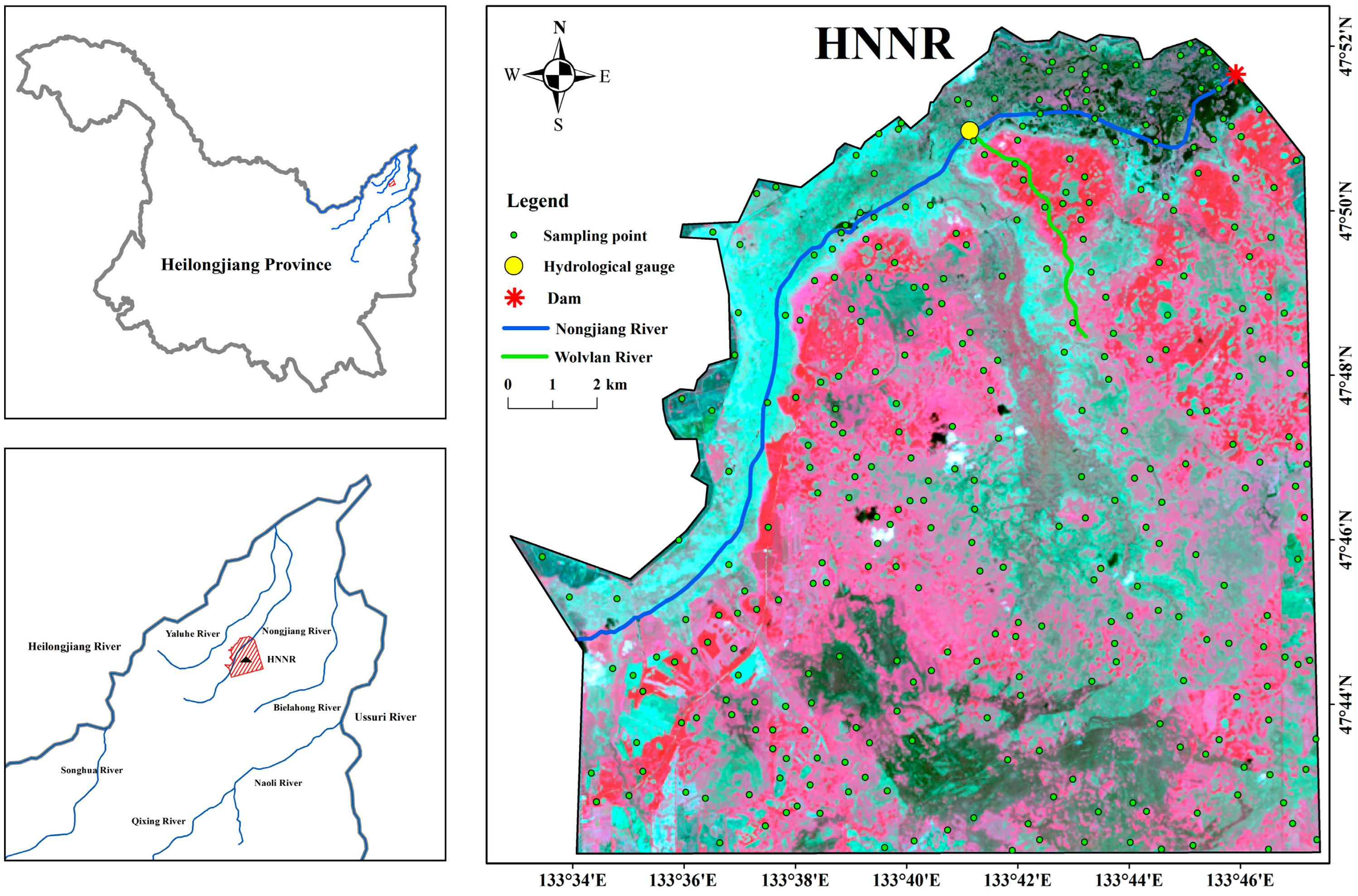
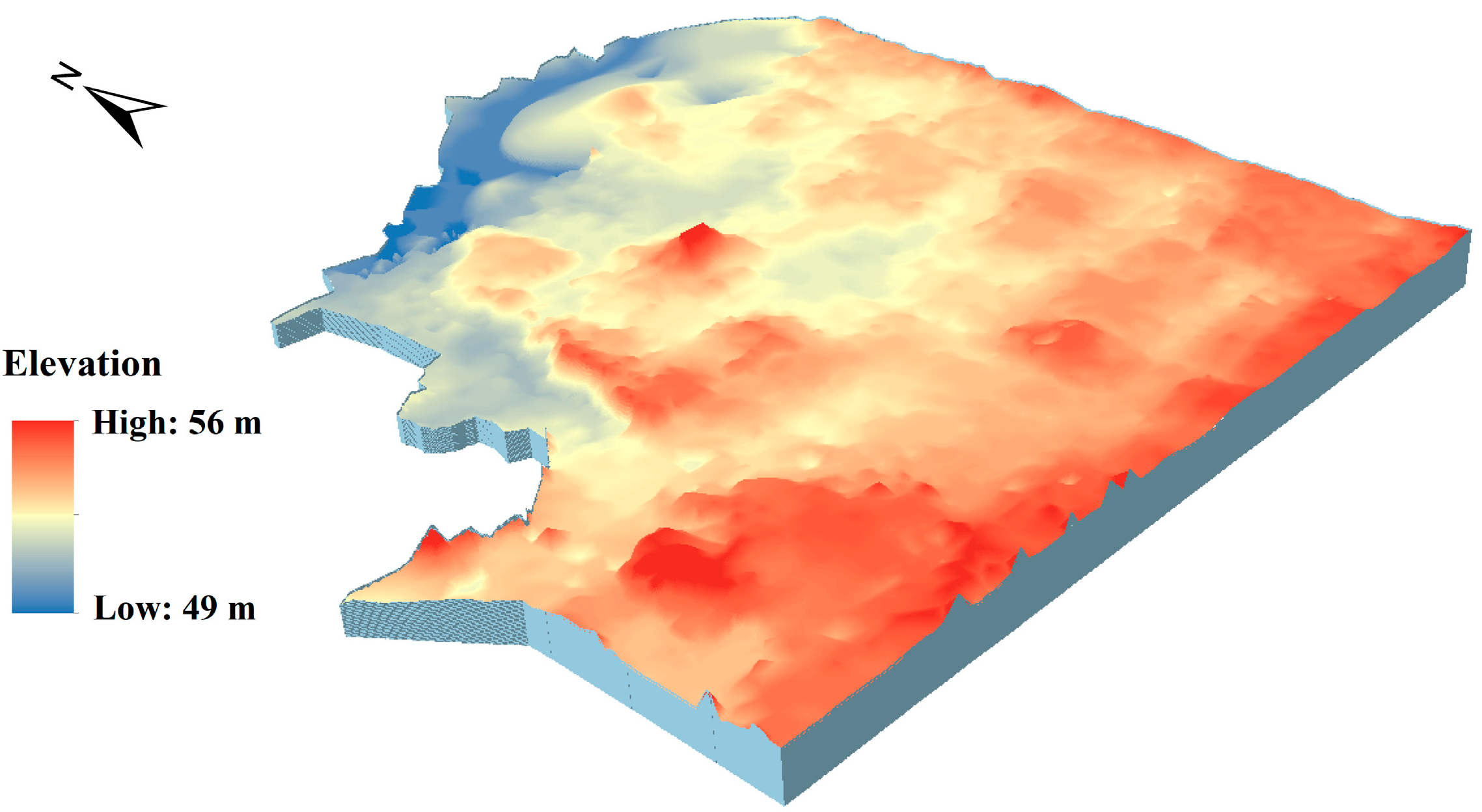

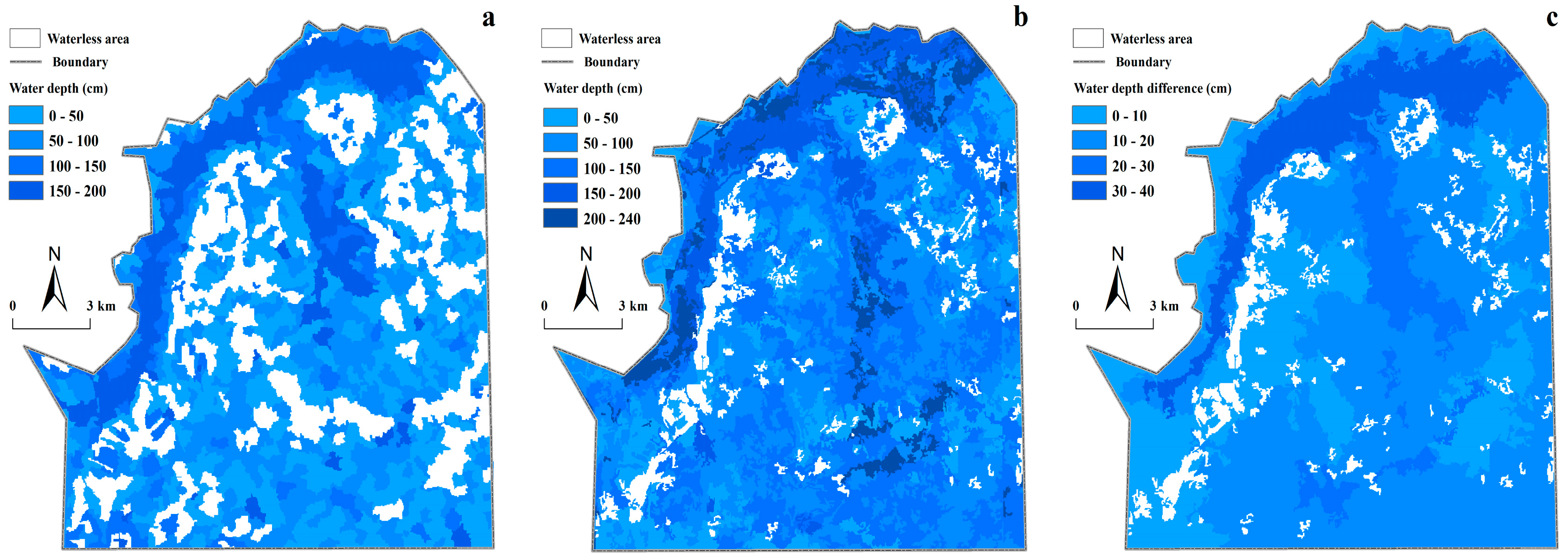
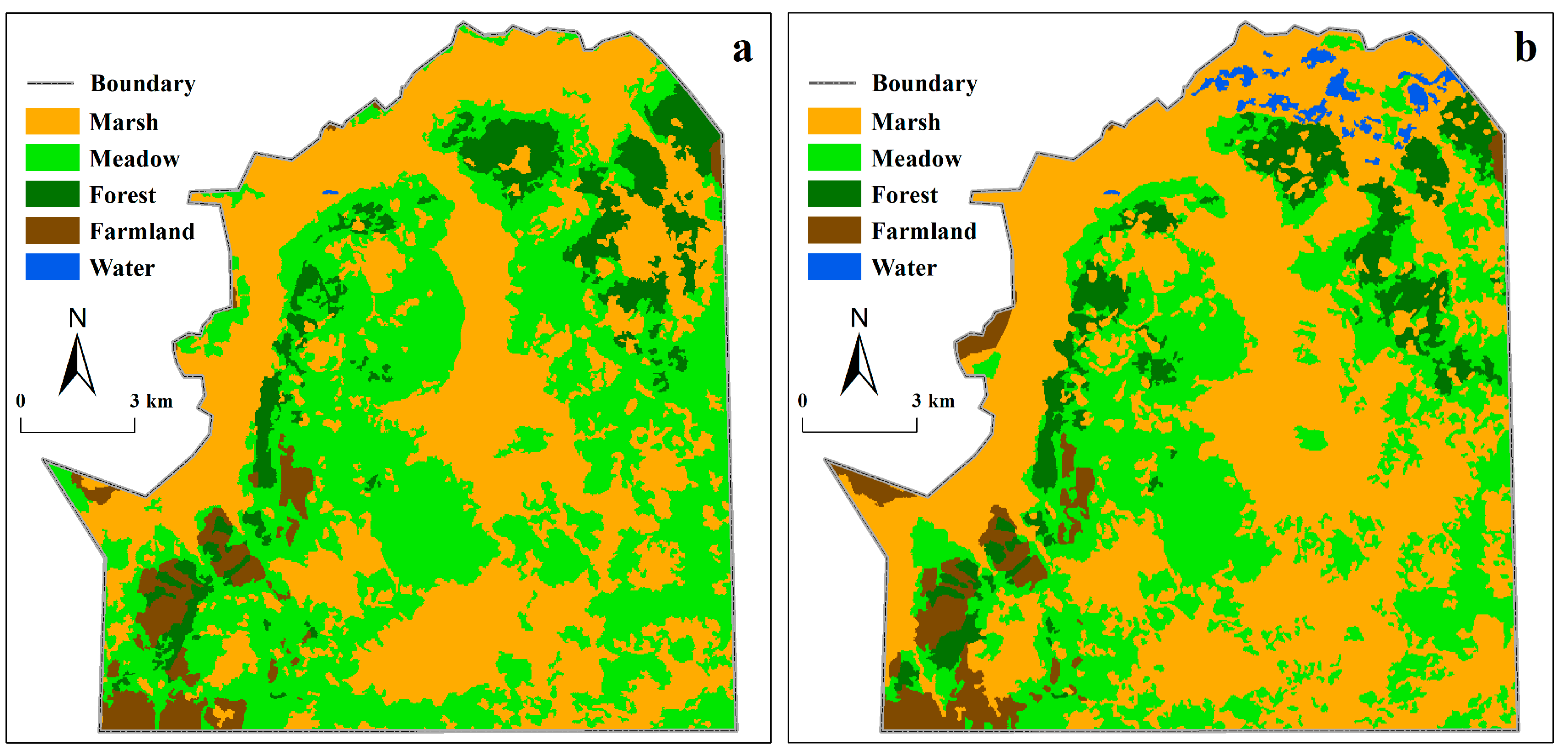
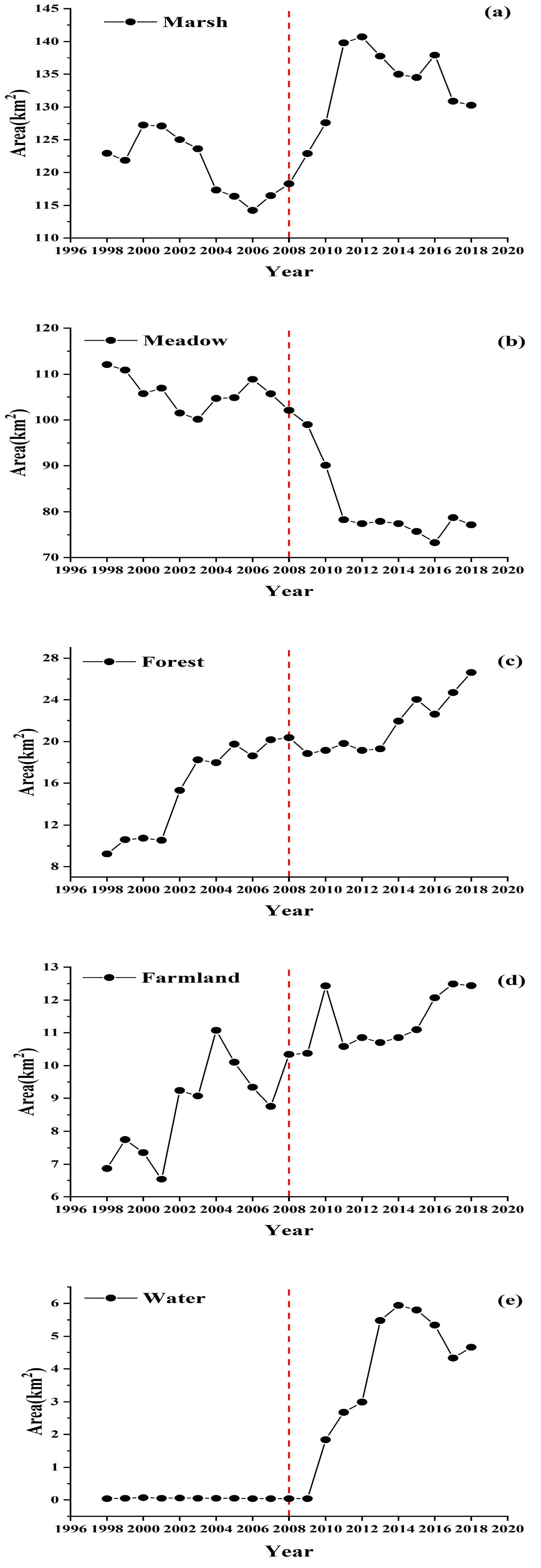

| Vegetation Type | Water Level Changes | Number of Patches (Piece) | Area (km2) | AI (%) |
|---|---|---|---|---|
| Marsh | The original water level | 167 | 118.24 | 94.86 |
| △Δ20 cm | 998 | 136.23 | 89.81 | |
| Δ40 cm | 906 | 145.12 | 92.48 | |
| Δ60 cm | 258 | 127.48 | 94.22 | |
| Meadow | The original water level | 137 | 102.09 | 92.90 |
| Δ20 cm | 692 | 77.2 | 88.12 | |
| Δ40 cm | 315 | 42.91 | 88.81 | |
| Δ60 cm | 223 | 9.47 | 84.46 | |
| Forest | The original water level | 87 | 20.37 | 90.68 |
| Δ20 cm | 46 | 7.35 | 88.68 | |
| Δ40 cm | 35 | 4.47 | 88.65 | |
| Δ60 cm | 27 | 3.23 | 89.70 | |
| Farmland | The original water level | 34 | 10.35 | 92.81 |
| Δ20 cm | 34 | 10.35 | 92.81 | |
| Δ40 cm | 34 | 10.35 | 92.81 | |
| Δ60 cm | 34 | 10.35 | 92.81 | |
| Water | The original water level | 1 | 0.04 | 90.48 |
| Δ20 cm | 697 | 19.96 | 79.31 | |
| Δ40 cm | 513 | 48.24 | 88.15 | |
| Δ60 cm | 241 | 100.56 | 94.39 |
| Year | 20 cm (Year 2009) | 40 cm (Year 2012) | 60 cm (Year 2015) | ||||
|---|---|---|---|---|---|---|---|
| Type | PA | UA | PA | UA | PA | UA | |
| Marsh | 0.70 | 0.56 | 1 | 0.51 | 1 | 0.4 | |
| Meadow | 0.57 | 0.46 | 0.35 | 0.41 | 0.05 | 0.25 | |
| Forest | 0.35 | 0.78 | 0.3 | 1 | 0.15 | 1 | |
| Farmland | 0.85 | 1 | 0.9 | 1 | 0.8 | 0.94 | |
| Water | 1 | 0.83 | 1 | 1 | 1 | 0.76 | |
| OA | 69.31% | 71% | 60% | ||||
| Kappa coefficients | 0.62 | 0.64 | 0.5 | ||||
Disclaimer/Publisher’s Note: The statements, opinions and data contained in all publications are solely those of the individual author(s) and contributor(s) and not of MDPI and/or the editor(s). MDPI and/or the editor(s) disclaim responsibility for any injury to people or property resulting from any ideas, methods, instructions or products referred to in the content. |
© 2023 by the authors. Licensee MDPI, Basel, Switzerland. This article is an open access article distributed under the terms and conditions of the Creative Commons Attribution (CC BY) license (https://creativecommons.org/licenses/by/4.0/).
Share and Cite
Zhang, X.; Liu, Y.; Zhao, W.; Li, J.; Xie, S.; Zhang, C.; He, X.; Yan, D.; Wang, M. Impact of Hydrological Changes on Wetland Landscape Dynamics and Implications for Ecohydrological Restoration in Honghe National Nature Reserve, Northeast China. Water 2023, 15, 3350. https://doi.org/10.3390/w15193350
Zhang X, Liu Y, Zhao W, Li J, Xie S, Zhang C, He X, Yan D, Wang M. Impact of Hydrological Changes on Wetland Landscape Dynamics and Implications for Ecohydrological Restoration in Honghe National Nature Reserve, Northeast China. Water. 2023; 15(19):3350. https://doi.org/10.3390/w15193350
Chicago/Turabian StyleZhang, Xuanyi, Yao Liu, Wei Zhao, Jingtai Li, Siying Xie, Chenyan Zhang, Xiaorou He, Dandan Yan, and Minhua Wang. 2023. "Impact of Hydrological Changes on Wetland Landscape Dynamics and Implications for Ecohydrological Restoration in Honghe National Nature Reserve, Northeast China" Water 15, no. 19: 3350. https://doi.org/10.3390/w15193350






